A small inside day continues a small consolidation. The main and alternate short-term Elliott wave counts remain essentially the same.
Summary: At this stage, it is possible that minor wave 3 could be over. Confidence in this view is required with a new low below 3,212.03.
If price continues higher, then the next target would be at 3,289.
Three large pullbacks or consolidations (fourth waves) during the next 1-2 years are expected: for minor wave 4 (coming soon, possibly tomorrow), then intermediate (4), and then primary 4. Extreme conditions warrant more careful attention to risk management at this time.
The biggest picture, Grand Super Cycle analysis, is here.
Monthly charts were last published here, with video here. There are two further alternate monthly charts here, with video here.
ELLIOTT WAVE COUNTS
The two weekly Elliott wave counts below will be labelled First and Second. They may be about of even probability. When the fifth wave currently unfolding on weekly charts may be complete, then these two wave counts will diverge on the severity of the expected following bear market. To see an illustration of this future divergence monthly charts should be viewed.
FIRST WAVE COUNT
WEEKLY CHART
The basic Elliott wave structure consists of a five wave structure up followed by a three wave structure down (for a bull market). This wave count sees the bull market beginning in March 2009 as an incomplete five wave impulse and now within the last fifth wave, which is labelled cycle wave V. This impulse is best viewed on monthly charts. The weekly chart focusses on the end of it.
Elliott wave is fractal. This fifth wave labelled cycle wave V may end a larger fifth wave labelled Super Cycle wave (V), which may end a larger first wave labelled Grand Super Cycle wave I.
The teal Elliott channel is drawn using Elliott’s first technique about the impulse of Super Cycle wave (V). Draw the first trend line from the end of cycle wave I (off to the left of the chart, the weekly candlestick beginning 30th November 2014) to the end of cycle wave III, then place a parallel copy on the end of cycle wave II (off to the left of the chart, the weekly candlestick beginning 14th February 2016). This channel perfectly shows where cycle wave IV ended at support. The strongest portion of cycle wave III, the end of primary wave 3, overshoots the upper edge of the channel. This is a typical look for a third wave and suggests the channel is drawn correctly and the way the impulse is counted is correct.
Within Super Cycle wave (V), cycle wave III is shorter than cycle wave I. A core Elliott wave rule states that a third wave may never be the shortest. For this rule to be met in this instance, cycle wave V may not be longer in length than cycle wave III. This limit is at 3,477.39.
Cycle wave V may subdivide either as an impulse or an ending diagonal. Impulses are much more common, and it is clear at this stage that cycle wave V is an impulse and not a diagonal.
At this stage, cycle wave V may take another one to two or so years to complete.
The daily chart below will focus on movement from the end of intermediate wave (2) within primary wave 3.
In historic analysis, two further monthly charts have been published that do not have a limit to upwards movement and are more bullish than this wave count. Members are encouraged to consider those possibilities (links below summary) alongside the wave counts presented on a daily and weekly basis. It is my judgement that the two weekly wave counts published in this analysis have the highest probability, so they shall be the only wave counts published on a daily basis.
Within cycle wave V, primary waves 1 and 2 may be complete. Within primary wave 3, intermediate waves (1) and (2) may be complete. Within the middle of intermediate wave (3), minor wave 4 may not move into minor wave 1 price territory below 3,021.99.
DAILY CHART
All of primary wave 3, intermediate wave (3) and minor wave 3 may only subdivide as impulses.
Minor wave 3 has passed 1.618 the length of minor wave 1, and within it minute wave v has passed equality in length with minute wave i. The next target may be now about 3,289 where minuette wave (v) within minute wave v would reach 1.618 the length of minuette wave (i).
Minor wave 2 was a sharp deep pullback, so minor wave 4 may be expected to be a very shallow sideways consolidation to exhibit alternation. Minor wave 2 lasted 2 weeks. Minor wave 4 may be about the same duration, or it may be a longer lasting consolidation. Minor wave 4 may end within the price territory of the fourth wave of one lesser degree; minute wave iv has its range from 3,154.26 to 3,070.49.
Minor wave 4 may not move into minor wave 1 price territory below 3,021.99.
Intermediate wave (3) has now moved far enough above the end of intermediate wave (1) to allow intermediate wave (4) to unfold and remain above intermediate wave (1) price territory.
Draw an acceleration channel now about intermediate wave (3): draw the first trend line from the end of minor wave 1 to the last high, then place a parallel copy on the end of minor wave 2. Keep redrawing the channel as price makes new highs. Minor wave 4 may find support at the lower edge of this channel if it is long lasting or deep enough.
Price is approaching the upper edge of the wide teal channel copied over from monthly and weekly charts. If price gets up to this trend line, then a reaction downwards there would be highly likely.
HOURLY CHART
It is possible that minor wave 3 may be close to completion.
Within minuette wave (v), subminuette waves i and ii may be complete. Subminuette wave iii may only subdivide as an impulse. Within subminuette wave iii, micro wave 2 may not move beyond the start of micro wave 1 below 3,214.64.
I have considered the possibility that minuette wave (iv) may be continuing sideways as a running contracting triangle. However, that idea requires seeing the upwards wave labelled here subminuette wave i as a three instead of as a five, which fits very well.
ALTERNATE HOURLY CHART
If price breaks below 3,214.64, then assume minor wave 4 has arrived.
If minor wave 4 ends within the price territory of the fourth wave of one lesser degree, then it may end about the 0.382 Fibonacci ratio of minor wave 3 about 3,105.
To begin a movement at minor degree a five wave structure downwards should develop on the hourly chart. Within the first five down, minuette wave (ii) may not move beyond the start of minuette wave (i) above 3,258.14.
SECOND WAVE COUNT
WEEKLY CHART
This weekly chart is almost identical to the first weekly chart, with the sole exception being the degree of labelling.
This weekly chart moves the degree of labelling for the impulse beginning in March 2009 all down one degree. This difference is best viewed on monthly charts.
The impulse is still viewed as nearing an end; a fifth wave is still seen as needing to complete higher. This wave count labels it primary wave 5. Primary wave 5 may still need another year to two or so to complete, depending upon how time consuming the corrections within it may be.
Primary wave 5 may be subdividing as an impulse, in the same way that cycle wave V is seen for the first weekly chart.
TECHNICAL ANALYSIS
MONTHLY CHART
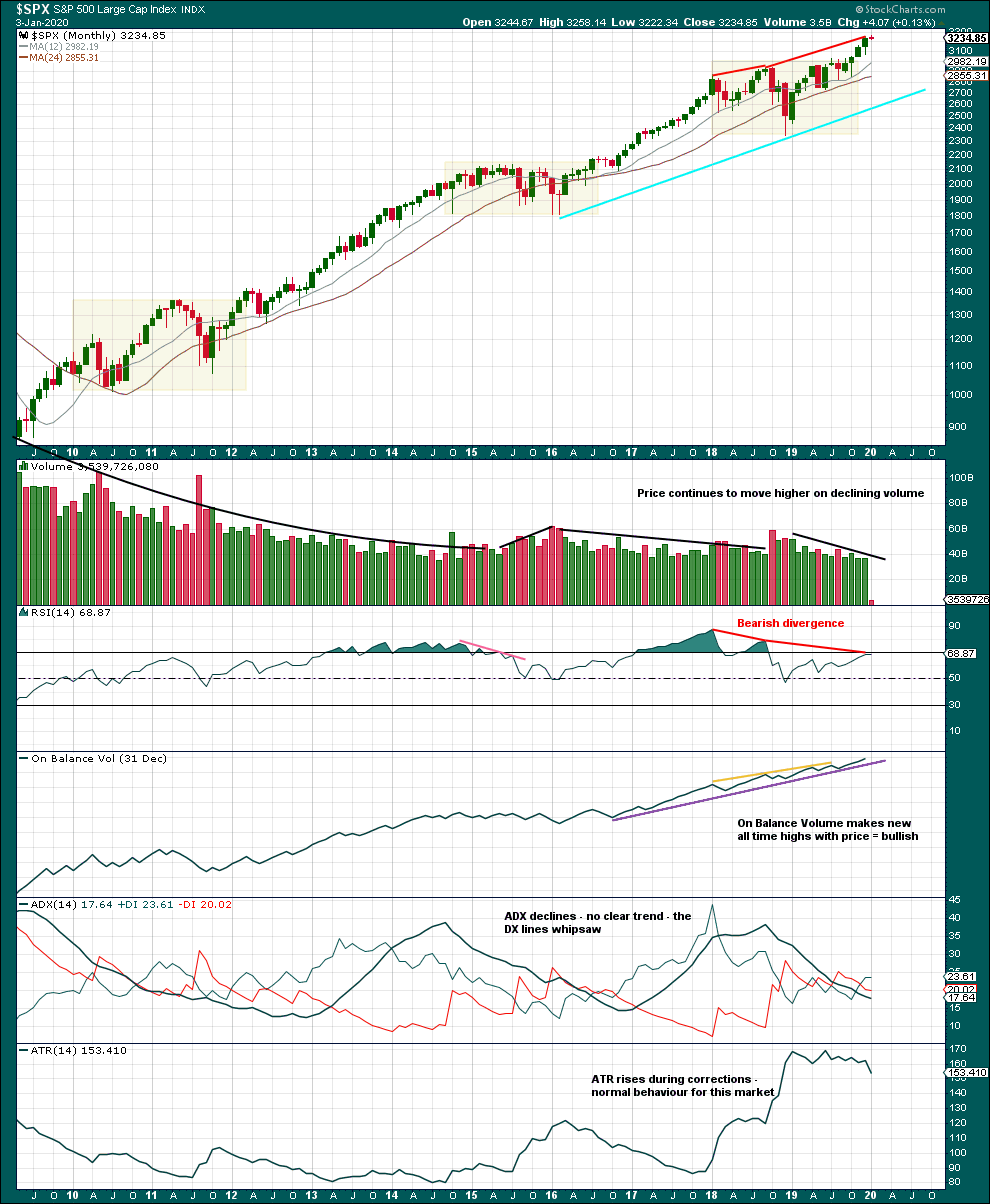
Click chart to enlarge. Chart courtesy of StockCharts.com.
There are three large consolidations noted on this chart, in shaded areas. After a breakout from a multi-month consolidation, it is reasonable to expect a multi month bullish move may result.
Note that in each of the first two cases a pullback saw price re-enter the consolidation zone after the breakout, before price then moved up and away. It is possible that may happen again after the last breakout from a consolidation.
This chart very clearly exhibits rising price on declining volume has now persisted for several years. A decline in volume last month, in current market conditions, is not of concern.
On Balance Volume supports the Elliott wave count.
WEEKLY CHART
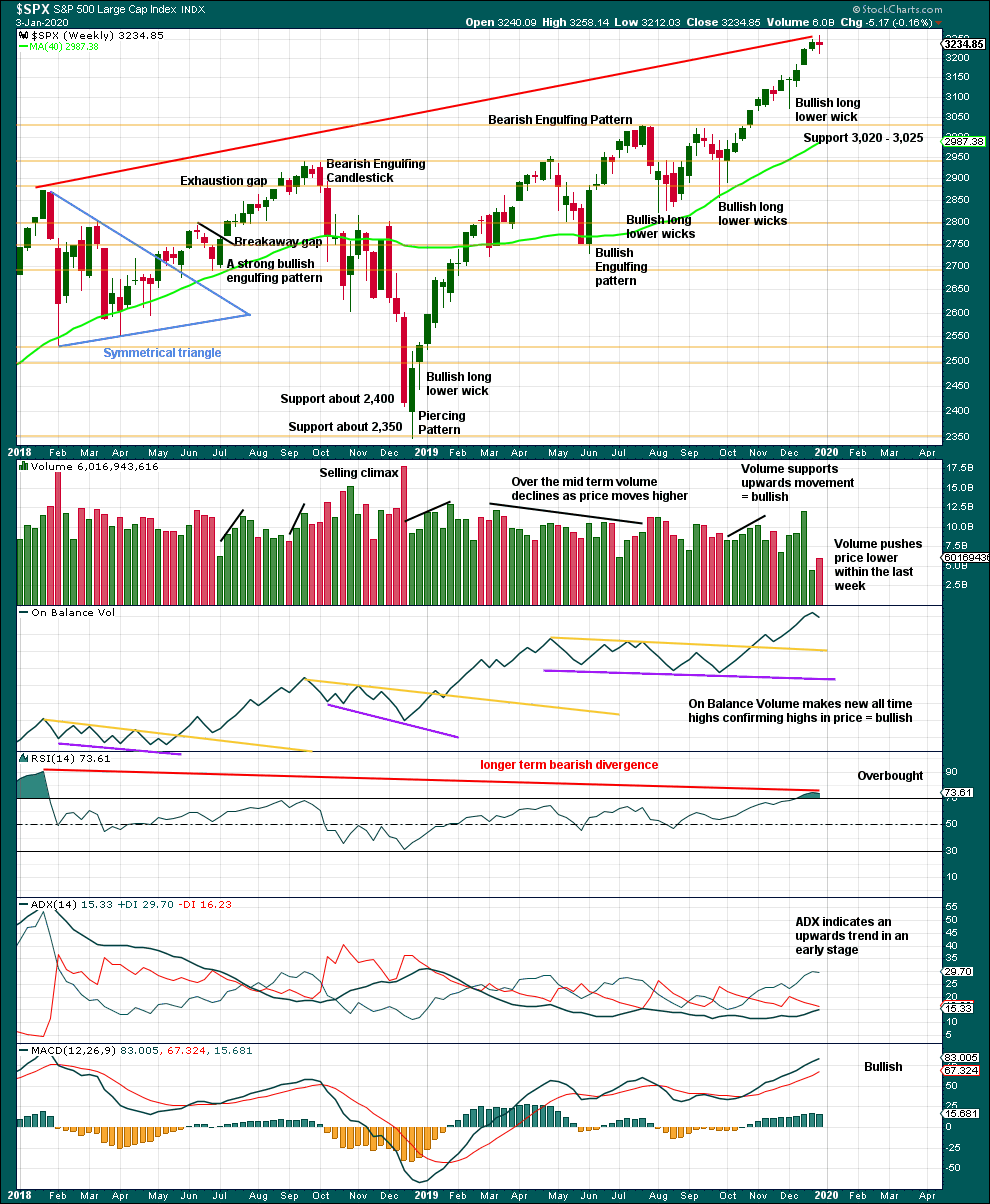
Click chart to enlarge. Chart courtesy of StockCharts.com.
It is very clear that the S&P is in an upwards trend and the bull market is continuing. Price does not move in straight lines; there will be pullbacks and consolidations along the way.
This chart is overall bullish. There are no signs of weakness in upwards movement.
RSI is now overbought. That does not mean upwards movement must end here, because it can continue for several weeks while RSI reaches more extreme. RSI reaching overbought is a warning that conditions are now becoming extreme. A pullback or consolidation will follow and the longer conditions are extreme the closer this will be. However, assume the trend remains the same until proven otherwise. This warning should be heeded by careful attention to risk management.
The doji last week on its own is not a reversal signal. It is a sign of a small pause.
DAILY CHART
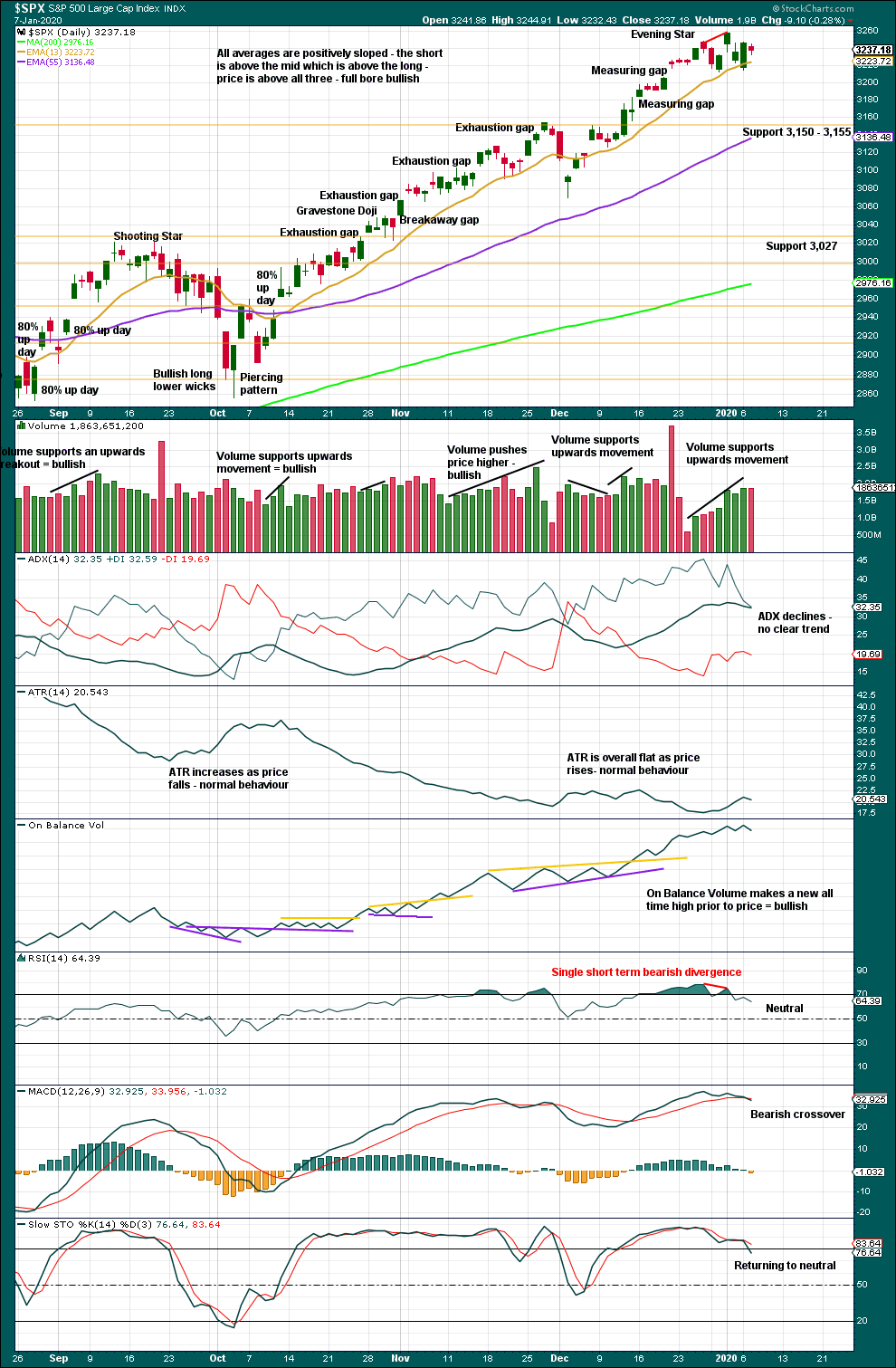
Click chart to enlarge. Chart courtesy of StockCharts.com.
There is an upwards trend in place. There will be corrections along the way.
Like the weekly chart, this chart is bullish.
RSI now exhibits bearish divergence while overbought. This is often (not always) a warning of a pullback or consolidation to develop.
Some sideways movement of the last three sessions has now brought RSI down from extreme and Stochastics returning to neutral. This may be another small consolidation within the ongoing upwards trend, but the risk of a larger consolidation or pullback here remains high.
BREADTH – AD LINE
WEEKLY CHART
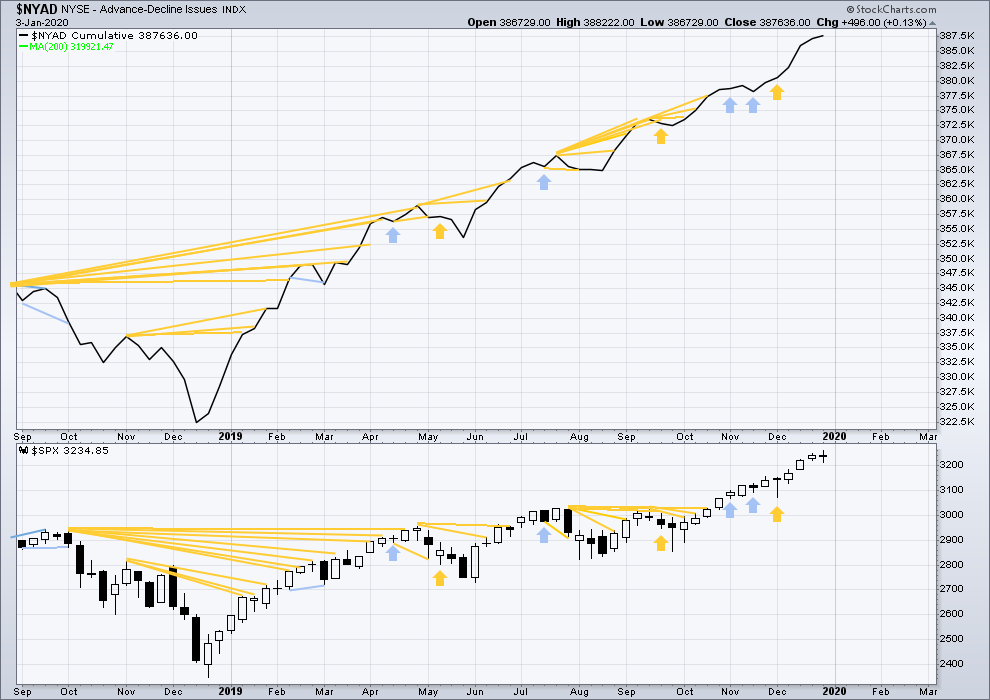
Click chart to enlarge. Chart courtesy of StockCharts.com. So that colour blind members are included, bearish signals
will be noted with blue and bullish signals with yellow.
Bear markets from the Great Depression and onwards have been preceded by an average minimum of 4 months divergence between price and the AD line with only two exceptions in 1946 and 1976. With the AD line making new all time highs this week, the end of this bull market and the start of a new bear market is very likely a minimum of 4 months away, which is the beginning of May 2020.
In all bear markets in the last 90 years there is some positive correlation (0.6022) between the length of bearish divergence and the depth of the following bear market. No to little divergence is correlated with more shallow bear markets. Longer divergence is correlated with deeper bear markets.
If a bear market does develop here, it comes after no bearish divergence. It would therefore more likely be shallow.
All of small, mid and large caps have made new swing highs above the prior swing high on the 13th of September, and mid caps have now made new all time highs. This upwards movement appears to be mostly driven by large caps, which is a feature of aged bull markets. This bull market at over 10 years duration certainly fits the definition of aged.
Again both price and the AD line have made new all time highs. There is no divergence. Upwards movement has support from rising market breadth.
Large caps all time high: 3,258.14 on 2nd January 2020.
Mid caps all time high: 2,073.72 on 2nd January 2020.
Small caps all time high: 1,100.58 on 27th August 2018.
DAILY CHART
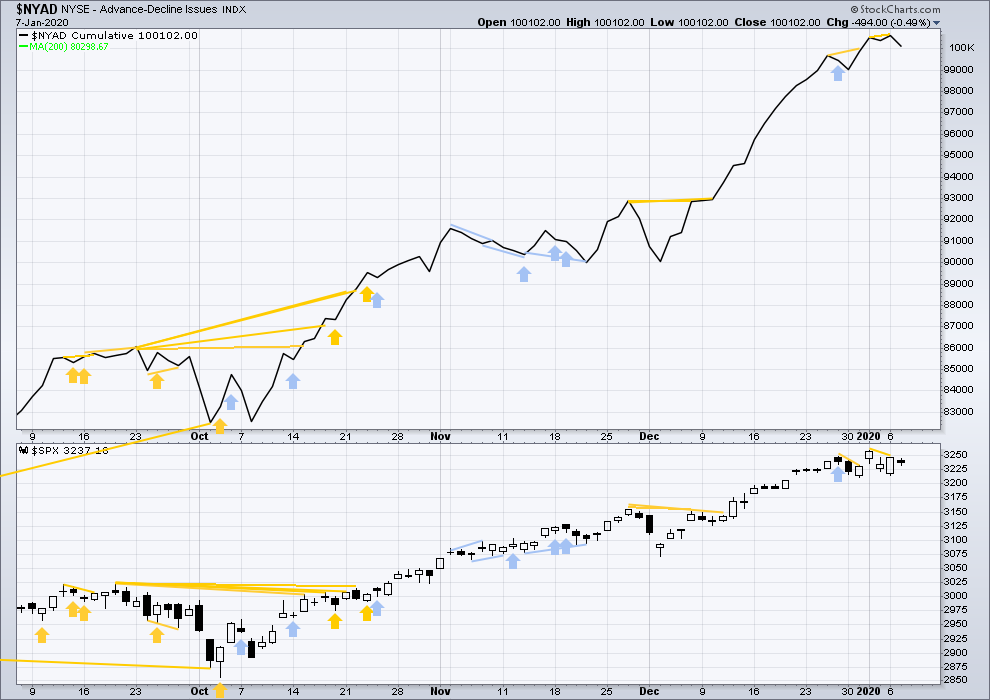
Click chart to enlarge. Chart courtesy of StockCharts.com. So that colour blind members are included, bearish signals
will be noted with blue and bullish signals with yellow.
Breadth should be read as a leading indicator.
A small range inside day today closes red. Downwards movement within this session comes with a normal corresponding decline in market breadth. There is no new divergence.
VOLATILITY – INVERTED VIX CHART
WEEKLY CHART
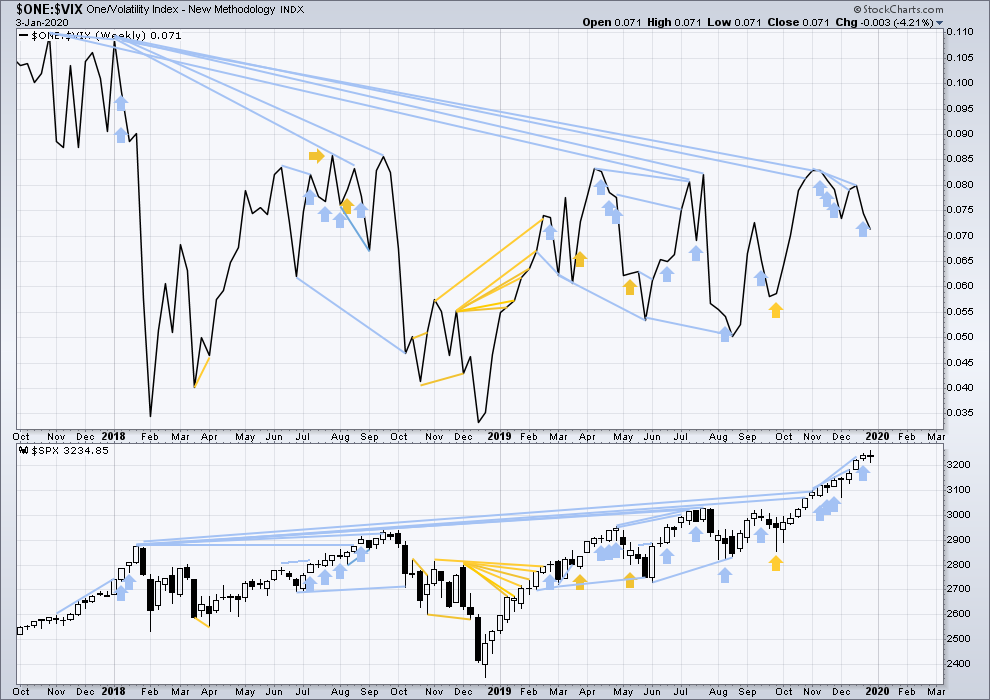
Click chart to enlarge. Chart courtesy of StockCharts.com. So that colour blind members are included, bearish signals
will be noted with blue and bullish signals with yellow.
The all time high for inverted VIX was on 30th October 2017. There is now over two years of bearish divergence between price and inverted VIX.
The rise in price is not coming with a normal corresponding decline in VIX; VIX remains elevated. This long-term divergence is bearish and may yet develop further as the bull market matures.
This divergence may be an early warning, a part of the process of a top developing that may take years. It may is clearly not useful in timing a trend change from bull to a fully fledged bear market.
Last week completes an outside week. Inverted VIX has declined during the week. There is no new short-term divergence.
DAILY CHART
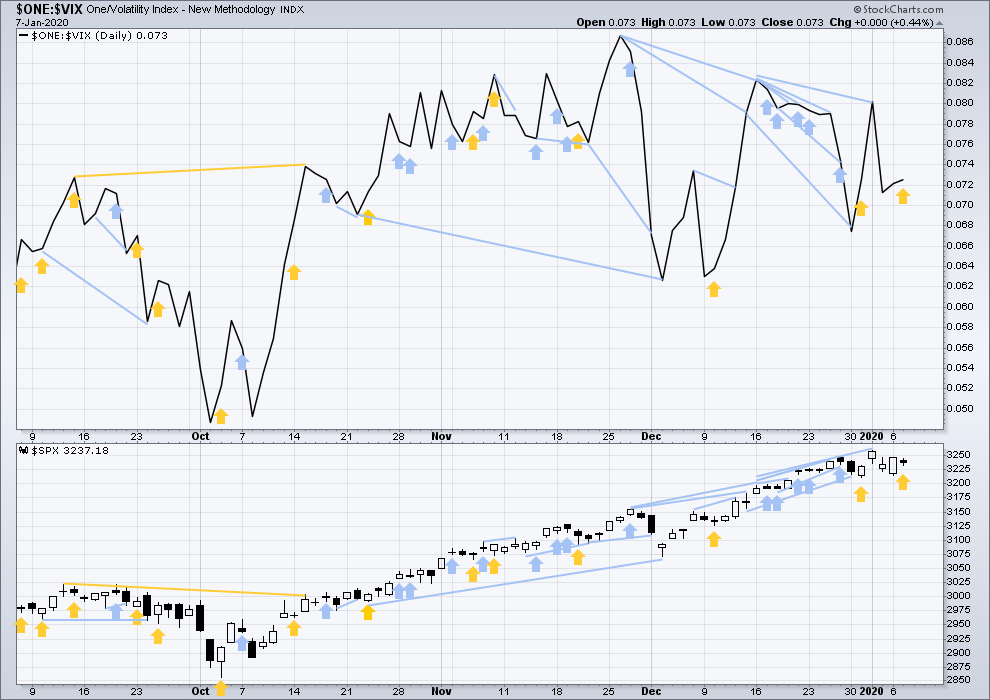
Click chart to enlarge. Chart courtesy of StockCharts.com. So that colour blind members are included, bearish signals
will be noted with blue and bullish signals with yellow.
This last session completed a small range inside day, which closed red, but inverted VIX has moved higher. Downwards movement within this last session does not come with a normal corresponding increase in VIX. VIX has declined. This may be considered bullish divergence.
DOW THEORY
Dow Theory confirmed a bear market in December 2018. This does not necessarily mean a bear market at Grand Super Cycle degree though; Dow Theory makes no comment on Elliott wave counts. On the 25th of August 2015 Dow Theory also confirmed a bear market. The Elliott wave count sees that as part of cycle wave II. After Dow Theory confirmation of a bear market in August 2015, price went on to make new all time highs and the bull market continued.
DJIA: 23,344.52 – a close on the 19th of December at 23,284.97 confirms a bear market.
DJT: 9,806.79 – price has closed below this point on the 13th of December.
S&P500: 2,532.69 – a close on the 19th of December at 2,506.96 provides support to a bear market conclusion.
Nasdaq: 6,630.67 – a close on the 19th of December at 6,618.86 provides support to a bear market conclusion.
With all the indices having moved higher following a Dow Theory bear market confirmation, Dow Theory would confirm a bull market if the following highs are made:
DJIA: 26,951.81 – a close above this point has been made on the 3rd of July 2019.
DJT: 11,623.58 – to date DJT has failed to confirm an ongoing bull market.
S&P500: 2,940.91 – a close above this point was made on the 29th of April 2019.
Nasdaq: 8,133.30 – a close above this point was made on the 26th of April 2019.
Published @ 08:54 p.m. EST.
—
Careful risk management protects your trading account(s).
Follow my two Golden Rules:
1. Always trade with stops.
2. Risk only 1-5% of equity on any one trade.
—
New updates to this analysis are in bold.

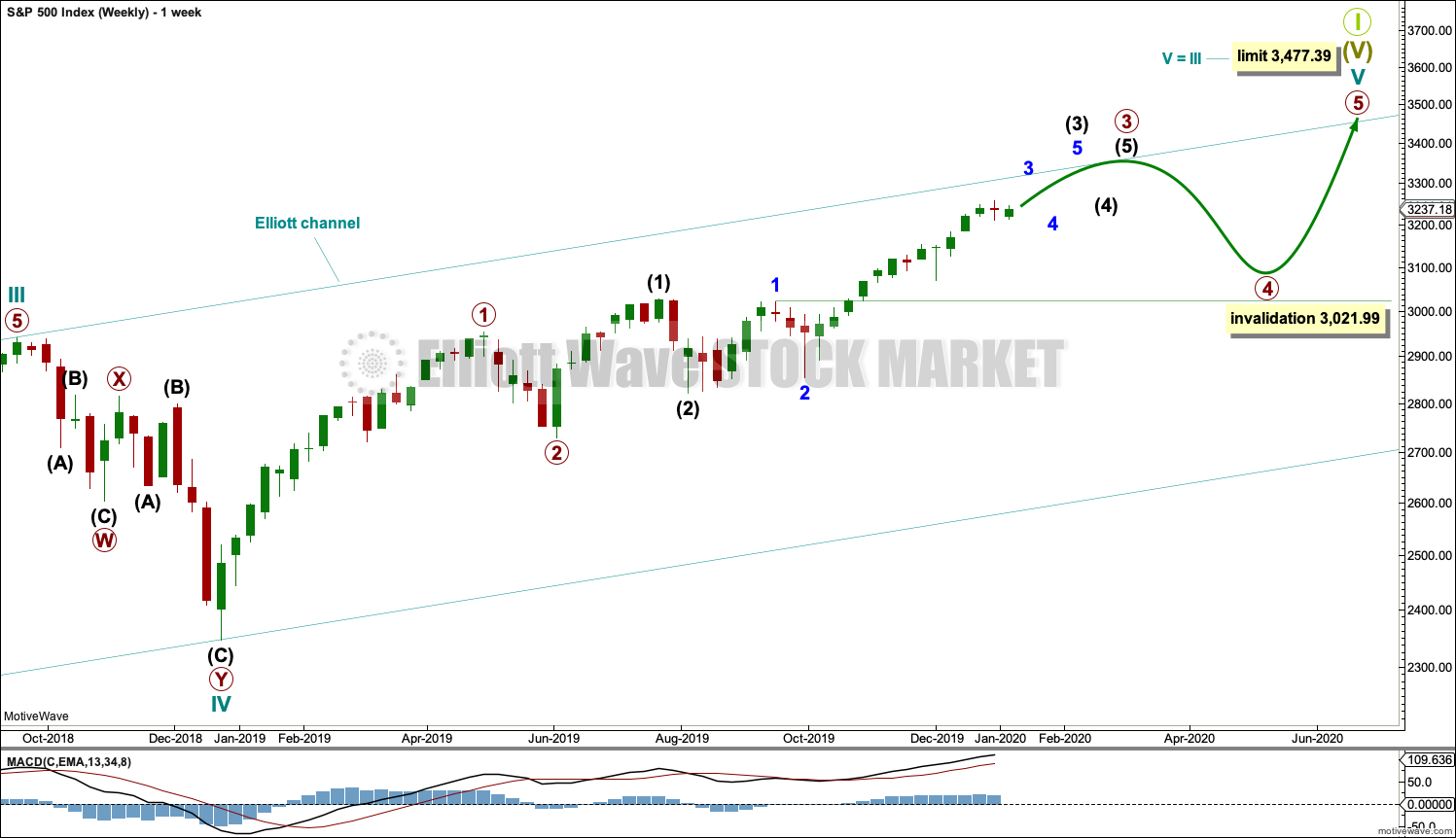
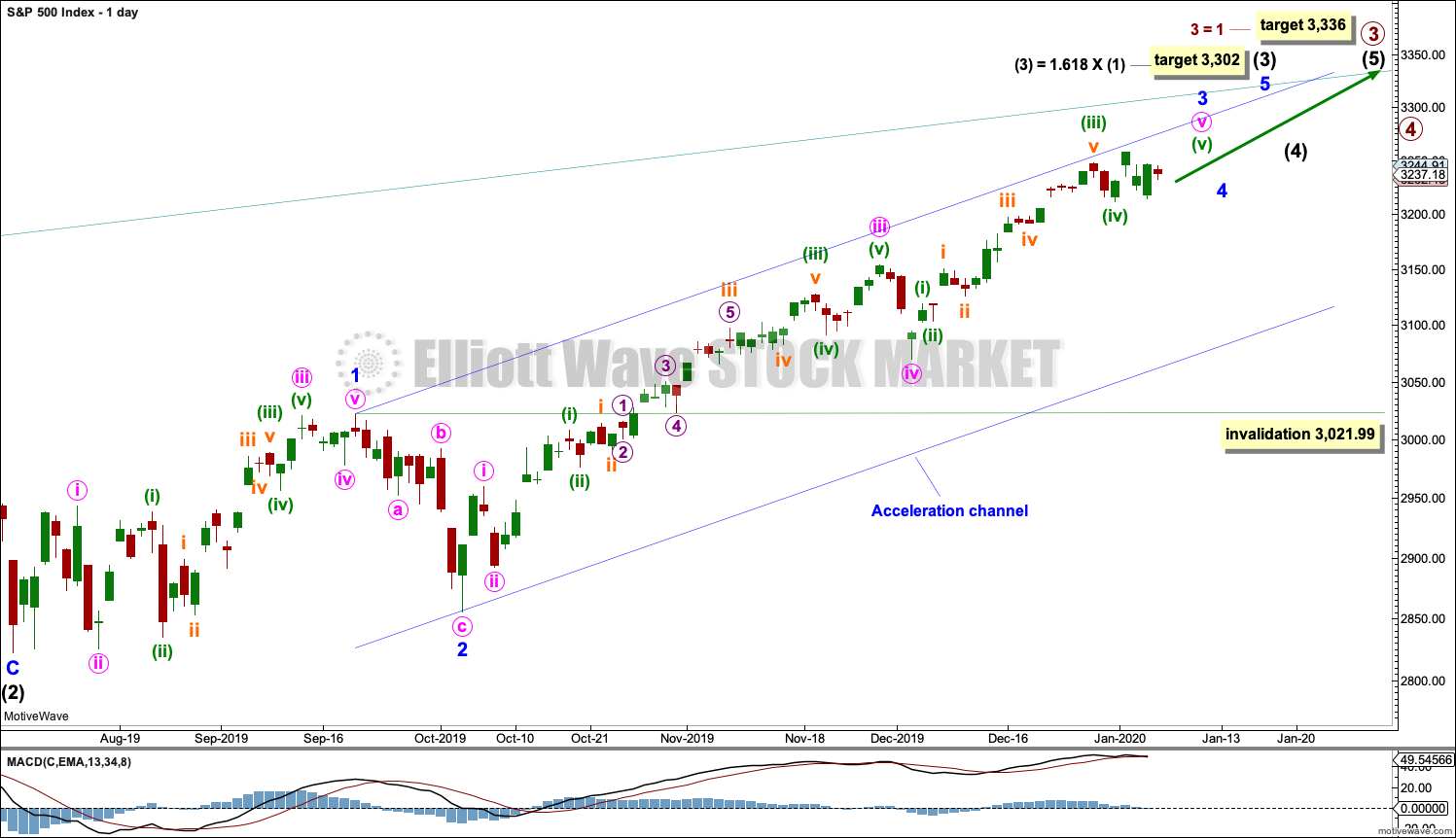
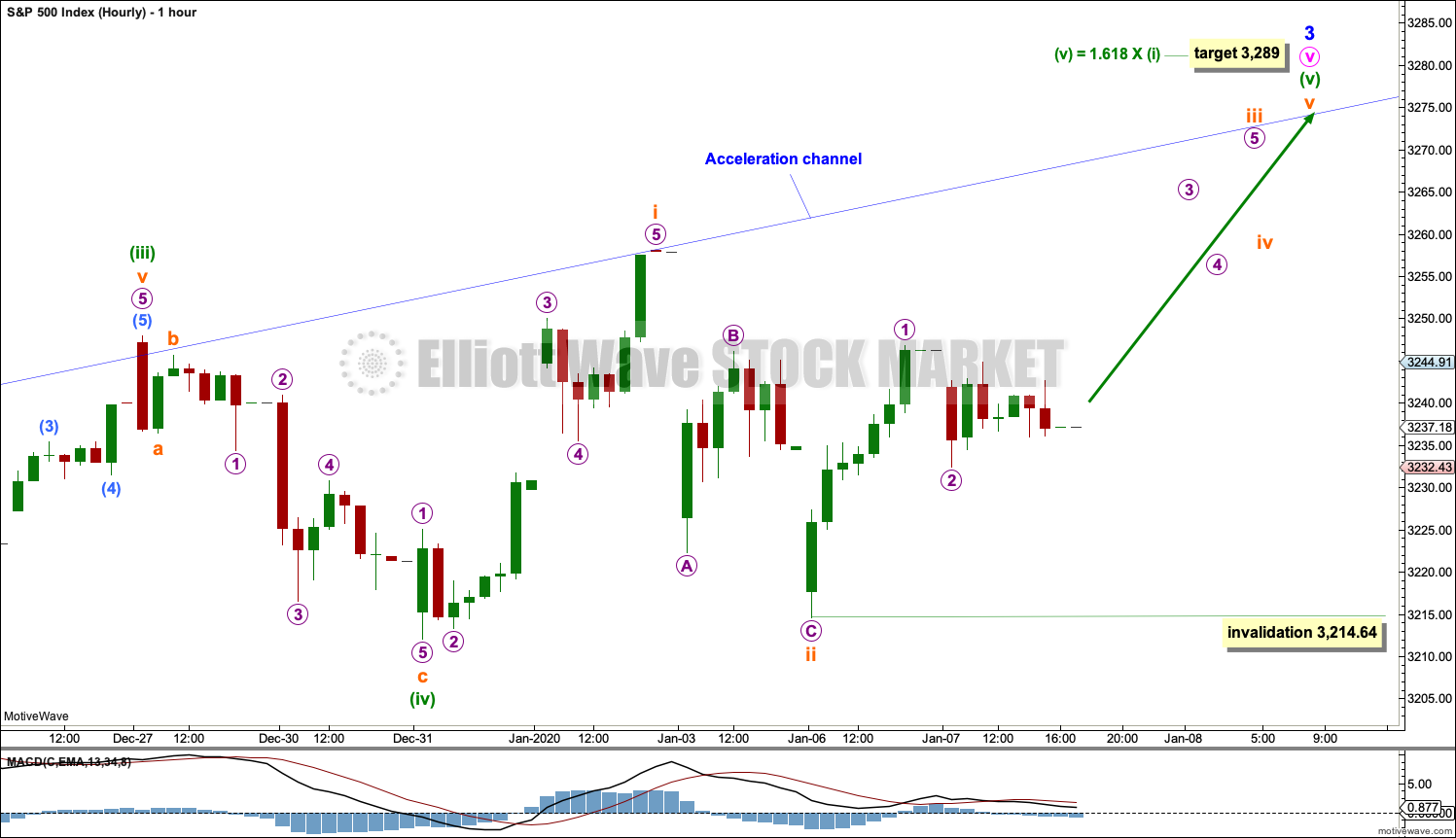
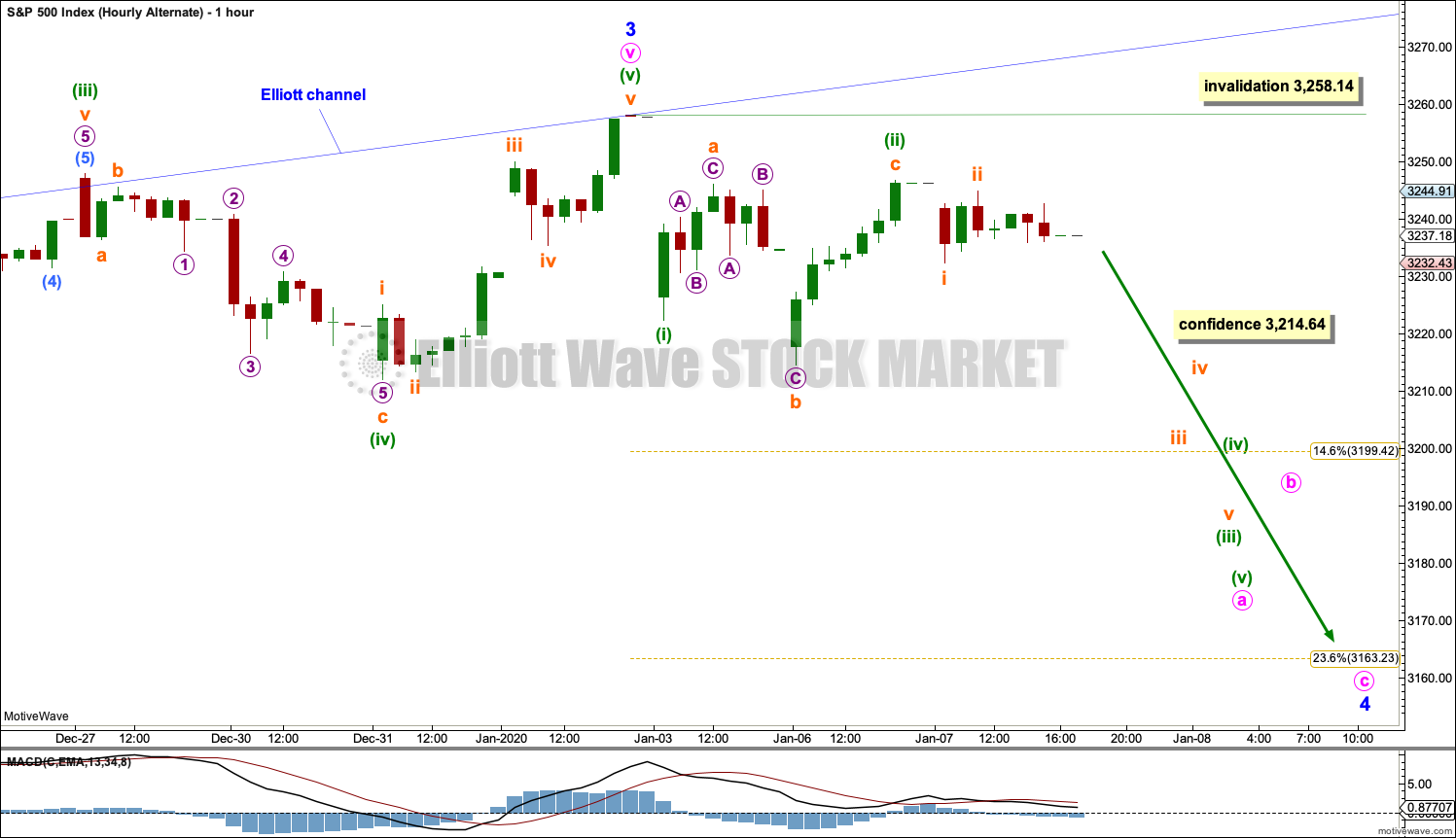
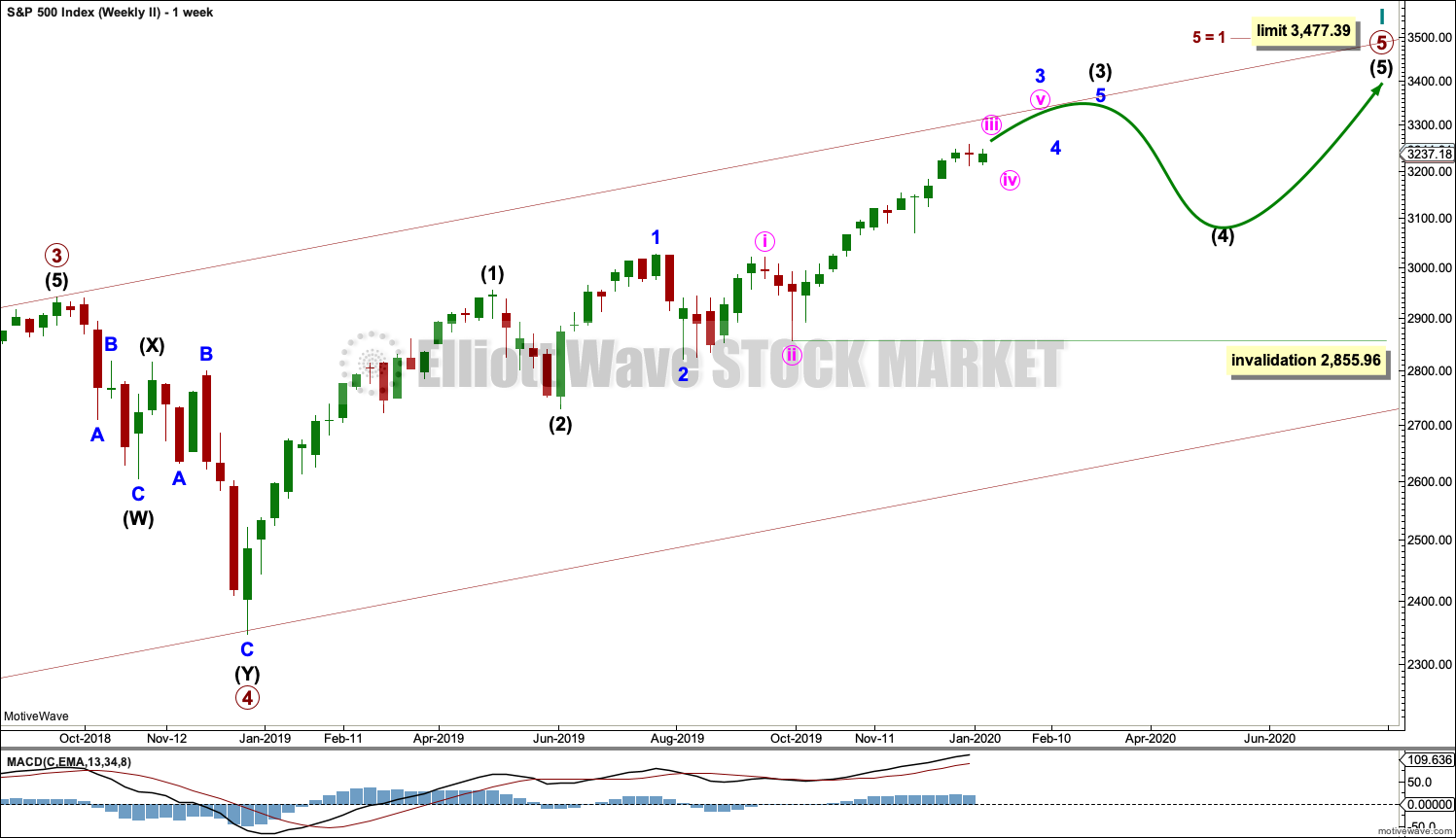
Is it possible that this could be starting wave C of an expanding flat beginning at the high of Jan 2?
Gold (GLD here, daily) has perfectly tagged my multiple fibonacci fitted overlapped targets (blue dashed lines) a couple of times and bounced down hard off it. I expect several days at least of some degree of 4 wave action under that level now.
The equity markets are getting a bit frothy for my liking. FWIW, I may be exiting my long positions soon (like tomorrow or Friday) and wait for Minor 4 to develop. When it looks like a low of Minor 4 may be in, I will begin another long position accumulation. I may end up giving away some upside profits by exiting too soon. However, I am sitting on some substantial profits at this time. As such, I am getting a bit nervous so to speak. So, I will feel better being out of the market for a while as the next correction of a few weeks or more plays out.
DING DING DING!!!
Rodney sell indicator is firing.
In fact, I have sold 50% of all my long positions at the close today.
I will let the remainder ride for a few more days or up to SPX 3300-3325. We have to let the waves play out day by day.
FWIW, I don’t use the overnight futures prices for any EW count. EW relies upon mass psychology and herd mentality etc. The overnight futures do not represent the mass market because it is a much, much smaller market.
Seems like there is more than me selling into the close.
Is it just the futures price that reached a low of 3180?
About 3182 overnight, yes. Then turned and went straight up pretty much since.
Main hourly chart updated today:
Target remains the same, the invalidation point can be pulled up now. An impulse needs to complete for minuette (v), with three more little fourth wave corrections along the way.
This wave count has the best look and fit.
A new alternate hourly wave count.
What if minuette (iv) was a triangle? When it’s labelled as such, there are a couple of problems. Subminuette e comes to a too rapid end, it has a big truncation in micro wave C, and it falls far too short of the lower triangle A-C trend line for a normal look.
This wave count meets all EW rules and is possible, but the triangle looks wrong. It has a low probability IMO.
It would require one more slight new ATH, and then minor 4 could begin there.
The target projection for the triangle exit would be much higher than the 3260s.
I think that if the triangle is the right count, we are finishing wave 1 of (v) green, So more upside is needed.
A high time frame RUT update…RUT is (so far) exiting nine months of monthly time frame squeeze here in January. And has just executed a monthly macd bullish crossover above the zero line. Note the last time such a set up occurred and what following: Aug 2016. Very powerful bullish signals for the intermediate to longer term (and virtually identical to the same signals in SPX, which exited 8 months of squeeze and did the same macd crossover just a little earlier).
I might be off here, if course, but so far it seems that new down channel has been forming on /ES hourly chart.
Well based on the action pre-market, doesn’t seem like minor 4 has started… as per the main count iii or 3 could trend up into 70s after market open
From The Catlins, Tautuku Bay. With surf!
Fantastic! And look at those crowds…lol!!!
IKR! There’s absolutely zero surfers out there.
We had to work so didn’t surf those waves. Now the swell has picked up and it’s about 5ft. On a beach break I can’t get my longboard out in that, so no surfing for me today sadly.
We’ll probably go and look at some forest and waterfalls later today. That’ll do just fine
Looks like 4’s here. ES hourly.
ES chart and count generally is very different than SPX (ie ES RTH)…
So don’t be surprised with a gap up open and main count continuing to 3289… I’ll be cautious here… sellers are just absolutely pathetic in the current market
Hmm possibly but I doubt it. I agree they’re different markets and to a certain extent they travel different routes but they both end up at the same destination.
I’m going to politely disagree a bit with both of you. /ES is the head of the dog; SPX is the tail. The head moves “all the time” (overnight), while the tail only moves starting with a “jerk” (gaps often) during the day session. The counts only require minor differences at the lower timeframes to account for the /ES action that doesn’t show on SPX. I really, really value /ES as an analysis tool (for SPX trading) myself. I like seeing “the whole structure”.
If this is a continuing minuette iv it’s getting quite deep and quite long relative to the minuette ii; it’s losing proportionality. I think Lara’s marker is the one to watch: an SPX close below 3212. The churn here in /ES and SPX is really really high; screams “top” to me, and this action screams “top” to me. But it still may not be. Patience, Skywalker…
Very true Kevin. However as the day session continues and both markets are trading the tail definitely wags the head.
massive recovery after no casualties
To just above 61.8% for probable wave 2 pullback.